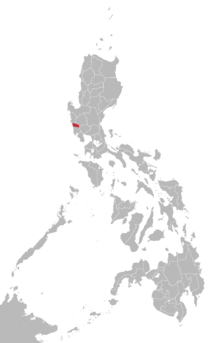lingvo.wikisort.org - Language
Botolan is a Sambalic language spoken by 32,867 (SIL 2000) Sambal, primarily in the Zambal municipalities of Botolan and Cabangan in the Philippines. Language status is 5 (developing). [2]
| Botolan | |
|---|---|
| Botolan Sambal | |
| Native to | Philippines |
| Region | some parts of Zambales province, Luzon |
Native speakers | 33,000 (2000)[1] |
Language family | Austronesian
|
| Official status | |
| Regulated by | Komisyon sa Wikang Filipino |
| Language codes | |
| ISO 639-3 | sbl |
| Glottolog | boto1242 |
 Area where Botolan Sambal is spoken according to Ethnologue | |
Varieties
The Ayta people of sitio Villar, Botolan, and sitio Kakilingan, Santa Fe, Cabangan also speak a Botolan dialect with some unique lexical items.[3]
Ethnologue reports Ayta Hambali (Hambali Botolan), Sambali Botolan as dialects of Sambal Botolan. Among themselves, Ayta Hambali reportedly use some words that are similar to Ayta, Mag-Anchi. [2]
Phonology
Botolan has 20 phonemes: 16 consonants and four vowels. Syllable structure is relatively simple. Each syllable contains at least a consonant and a vowel.[citation needed]
Vowels
Botolan has four vowels. They are:
- /a/ an open front unrounded vowel similar to English ‘father’
- /e/ a close-mid front unrounded vowel similar to German ‘Elefant’
- /i/ a close front unrounded vowel similar to English ‘machine’
- /u/ (written as ‘o’) a close back unrounded vowel similar to English ‘flute’
There are five main diphthongs: /aɪ/, /uɪ/, /aʊ/, /ij/, and /iʊ/.
Consonants
Below is a chart of Botolan consonants. All the stops are unaspirated. The velar nasal occurs in all positions including at the beginning of a word.
| Bilabial | Dental | Palatal | Velar | Glottal | ||
|---|---|---|---|---|---|---|
| Nasals | m | n | ɲ ⟨ny⟩ | ŋ ⟨ng⟩ | ||
| Plosives/ Affricates |
voiceless | p | t | tʃ ⟨ts, ty⟩ | k | ʔ - |
| voiced | b | d | dʒ ⟨dy⟩ | g | ||
| Fricatives | s | ʃ ⟨sy⟩ | h | |||
| Laterals | l | lj ⟨ly⟩ | ||||
| Flaps | r | |||||
| Semivowels | w | j | ||||
Note: Consonants /d/ and /ɾ/ can sometimes interchange as they were once allophones.
Stress
Stress is phonemic in Botolan. Stress on words is very important, they differentiate words with the same spellings, but with different meanings, e.g. hikó (I) and híko (elbow).
Historical sound changes
Many words pronounced with /s/ and /ɡ/ in Tagalog have /h/ and /j/, respectively, in their cognates in Botolan. Compare hiko and bayo with the Tagalog siko and bago.
Sample texts
The Lord’s Prayer
Version from Matthew
Tatay nawen ya anti ha katatag-ayan,
Hay ngalan mo ay igalang dayi nin kaganawan.
Andawaten nawen ya tampol kayna dayin mag-arí.
Mangyari dayi ya kalabayan mo bayri ha babon lotá
Bilang ombayro ha katatag-ayan.
Hapa-eg ay biyan mo kayin pamamangan ya
angka-ilanganen nawen.
Patawaren mo kayi ha kawkasalanan
nawen bilang pamatawad nawen ha nakapagkasalanan konnawen.
Agmo kayi biyan ma-irap ya pagsobok boy
ipakarayó mo kayi koni Satanas.[4]
Philippine national proverb
Below is a translation in Botolan of the Philippine national proverb[5] “He who does not acknowledge his beginnings will not reach his destination,” followed by the original in Tagalog.
- Botolan: “Hay ahe tanda nin nanlek ha pinangibatan, ay ahe makalateng ha lalakwen.”
- Tagalog: “Ang hindi marunong lumingon sa pinanggalingan ay hindi makararating sa paroroonan.”
See also
- Languages of the Philippines
References
- Botolan at Ethnologue (18th ed., 2015) (subscription required)
- "Ethnologue".(subscription required)
- Himes, Ronald S. (2012). "The Central Luzon Group of Languages". Oceanic Linguistics. 51 (2): 490–537. doi:10.1353/ol.2012.0013. JSTOR 23321866.
- "Botolan Sambal". Archived from the original on 2007-09-29. Retrieved 2007-09-22.
- "National Philippine Proverb in Various Philippine Languages". Carl Rubino's homepage.
- Antworth, Evan L. (1979). Grammatical Sketch of Botolan Sambal. Manila: Linguistic Society of the Philippines.
External links
- Grammar sketch of Botolan found on Carl Rubino's homepage
- Sample recordings from the GRN Network, in Botolan
- Hay Halita nin Diyos, Bible verses in Botolan
На других языках
- [en] Botolan language
[ru] Ботоланский язык
Ботолан — один из самбальских языков. Распространён в филиппинской провинции Самбалес, главным образом в муниципалитетах Ботолан и Кабанган. Количество носителей — 32 867 человек (SIL 2000). Довольно устойчивое положение, используется во всех сферах жизни и всеми возрастными группами.Другой контент может иметь иную лицензию. Перед использованием материалов сайта WikiSort.org внимательно изучите правила лицензирования конкретных элементов наполнения сайта.
WikiSort.org - проект по пересортировке и дополнению контента Википедии